![]() T is a curious freak of fortune which
has associated the little country of Denmark in most people’s minds with
two names representing the most contrasted personalities, Hamlet, the
protagonist of human speculation, and Hans Christian Andersen, the first
child-author. He was not the first to write for children, nor the first
to introduce the child into literature; another distinction belongs to
him: he was the first child who had contributed to literature. The work
by which he is best known is nothing more nor less than an artistic
creation of precisely the order which is common among children.
T is a curious freak of fortune which
has associated the little country of Denmark in most people’s minds with
two names representing the most contrasted personalities, Hamlet, the
protagonist of human speculation, and Hans Christian Andersen, the first
child-author. He was not the first to write for children, nor the first
to introduce the child into literature; another distinction belongs to
him: he was the first child who had contributed to literature. The work
by which he is best known is nothing more nor less than an artistic
creation of precisely the order which is common among children.
It is part of the common experience of men to endow inanimate things with more or less life through the operation of the imagination. Even mere symbols are made to have a superfluity of life. But the power of personifying that which seems to have no personality is strongest in childhood; it is very apt to die out or become indistinct in later years. Andersen never lost this power; be cultivated it; and that which with children is vivid but formless became with him even more vivid, but ordered and disposed as by the laws of art.
This, I think, may be taken as the peculiar contribution of Andersen to literature: he was the interpreter to the world of that creative power which is significant of childhood: the child spoke through him. He was himself, as his autobiography and the unvarying testimony of his friends show, a child all his life. The Naïveté which is so large an element in his stories was an expression of his own artless nature; his was a condition almost of arrested development. He was an excessively vain man, but his vanity was the innocent egotism of a child who wants everybody to look at him when he is doing anything which pleases himself. He bemoans with amusing simplicity the indifference which people showed to his philosophical writings; he avers with an air of injured innocence that he studied very hard, and was often reading difficult books at midnight, when people supposed he was amusing himself. He would have discontinued such trivial matters as writing his little tales, but they forced themselves from him.
It was hard for Andersen’s contemporaries to withhold their ridicule of this strange figure, and it is still difficult for Danes to accept cordially the conspicuous position in their literature which he holds in the eyes of foreigners. He wrote novels, poems, books of travel, and dramas. He ranked as an artist and a man of creative power in these forms below others of his time and nation, yet it will be found that when Danish literature is named, Andersen is quite the only figure in it of familiar repute beyond the boundaries of his own country, and this not by virtue of these larger works, but through a few wonder-stories.
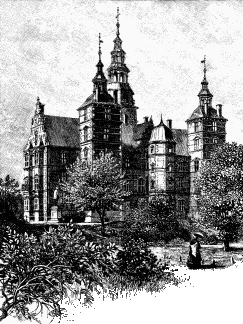
Andersen was by no means a man who preferred to associate with children. When it was proposed in his lifetime to erect in the Rosenborg Garden in Copenhagen a statue in his honor, various sculptors submitted designs. One of them was a pleasing one which would probably reflect the sentiment of most people regarding him; it represented the great storyteller with two children by his knee while he told them stories. Andersen objected positively to the conception, for he said he was not in the habit of taking children thus into his arms. The design which was chosen, and was presumably accepted by him, presents him in a curule chair, a cloak falling off his shoulders, while he bends forward, holding. with his finger between the leaves, a thin book, which might contain one of his stories, and stretching forth the other hand with an eager gesture. This eagerness, too, is in his face and his parted lips; he is reciting one of his stories. The statue, which is of bronze, stands upon a pedestal bearing in front his name, with dates of his birth and death, and on the sides pretty reliefs, the one of the Ugly Duckling group, the other of a child borne upon a stork. A simple inscription states that the statue was erected in 1880 by the Danish people in memory of time wonder-story poet.
The statue was planned before Andersen’s death in 1875, and his countrymen, who had been forced into a pride in his genius, and had adopted a good-natured tone of admiration toward him, somewhat as one might humor a spoiled child, entertained themselves with the thought that Andersen would every day take a walk in the Rosenborg Gardens and admire the bronze effigy of himself. I think they really regretted the loss of this reflected pleasure. Well, one might easily choose a less agreeable walk, even with somebody else’s statue than his own at the end of it. The garden is the resort of nursery-maids and children, and there in the sunny afternoons of the long Northern summer days one may see children sporting in the long avenue overhun1g with grateful shade, at the end of which, in a little garden plant, stands Andersen’s statue. Andersen had not a beautiful face, nor a graceful figure, but the sculptor, by giving the face the glow of animation and making the figure eager and unconseious, has achieved a signal triumph in a perfectly honest and truthful manner.
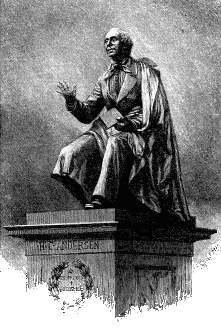
Intimate and extended mental association with the Danish story teller rendered very trivial sights and incidents in Copenhagen and Odense interesting to me. Sentences out of his stories of no sort of intrinsic value remained in my head, and came up to entertain me as I walked through the streets. In the introductlon for instance, to The Galoshes of Fortune, in Charles Boner’s admirable translation—Boner is much the best translator Andersen has had—the beginning reads: “Every author has some peculiarity in his descriptions or in his style of writing. Those who do not like him magnify it, shrug their shoulders, and exclaim, ‘There he is again!’ I, for my part, know very well how I can bring about this movement and this exclamation. It would happen immediately if I were to begin here as I intended to do, with, ‘Rome has its Corso, Naples its Toledo.’ ‘Ah, that Andersen! there he is again!’ they would cry. Yet I must, to please my fancy, continue quite quietly, and add, ‘but Copenhagen has its East Street.’”
As soon as I had chosen my quarters I sallied out, and struck at once into East Street, much pleased to find it as narrow, as winding, and as insignificant generally as Washington Street in Boston. What a charm and consolation it brings to us in our travels when the homely imagination which we have had proves to have been in excess of the fact! The people in East Street were innocent of any historic or literary consciousness. The shops were more ambitions to be French than to preserve Danish peculiarities and it was only by repeopling the place with Andersen’s characters and with himself that I could attain anything like an artistic satisfaction. It was thus that a perfectly commonplace street—Hyskenstraede (Small-houses Street)—tempted me its whole length, simply because it was associated in my mind with the story of The Old Bachelor’s Night-Cap, and I sought the Frederiks Hospital to see the dull, ordinary iron picket-fence in front of it, through which the unfortunate young man in The Galoshes of Fortune thrust his head. I even crossed over to Christianshavn, and set out on a walk to the east end of Amager, in order to reproduce for myself Andersens first literary venture, when be published his Journey on Foot from Holmens Kanal to the East Point of Amager.

But, after all, it was the Copenhagen of Andersen’s own fortune which interested me most. The story of his forlorn youth there, of the awkward, sensitive poet in his Ugly Duckling period, is one of the vivid sentences in modern literary history. Andersen wrote his experience for the Danish people, and he never had anything cosmopolitan about him, so that any one who reads sympathetically the early chapters of his autobiography must necessarily acquire a kind of intimacy with people who have very little historical significance. The names of Collin, Guldberg, Dahlen, Colbjörnsen, come to have for him an individuality which is absolutely the gift of Andersen, while the better known names of Ingemann, Heiberg, Oersted, Ochlenschläger, Weyse, Hertz, and others are identified by the passing references in the book. The frequent recurrence of these names in Andersen’s autobiography with familiar reference gives to the foreigner who is indebted to the book for his knowledge of Danish life a feeling as if he had known these people casually and under social conditions, not through literary history, so that Copenhagen, when he comes to visit the city, has been introduced to him by Andersen.
Of course such a knowledge is superficial enough, but it answers the agreeable purpose of making one feel at home in the city. Such a comfortable sensation is increased by what I may call the homeliness of Copenhagen. There is little that is striking in architectural feature. The Exchange with its twisted dragon spire is a picturesque red brick building of the Dutch Renaissance style, which is under careful restoration piece by piece. The Round Tower, attached to the Church of the Trinity, used once as an observatory for looking up, and now as an observatory for looking down and off, has only the character of a gigantic tube, up which one ascends by a paved roadway, rising in a gentle slope as it winds round a smaller tube. It would be possible to drive to the top, and emperors and queens and the like have amused themselves thus; but I followed the crowd, who clung to the inner wall going up, and trotted down by the larger outer circle. The walls, especially near the top, were scrawled with names and dates. I saw Rossini’s name in very bold letters. The Church of Our Saviour has a curious spiral staircase winding outside of the spire, and there is a quaint old facade from 1616 in the Amagertorv, but aside from these the public and private buildings would hold the eye accustomed to Flemish towns but a short time.
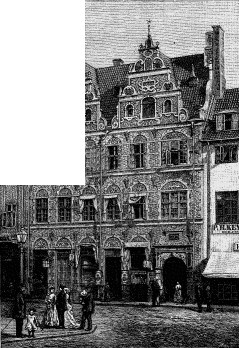
In the absence of any masterpieces of architecture, one returns to what I have characterized as the homeliness of the town. The churches are big, spacious, and hospitable houses. I remember especially the impression produced on me by Frederik’s Church in Christianshavn, where the square auditorium had very few seats on the floor, but was surrounded in the oddest manner by three galleries, with curtains before them, so that, if the congregation chose, it could draw its curtains and go to sleep while the minister prosed in his pulpit. In another church—the one with a spiral staircase about its spire—there were four tiers of these private boxes in the transepts, and wood-carving of the most demoralized sort met the eye when gazing at the huge altarpiece and at the organ, which was held up by two huge wooden elephants that served as caryatides.
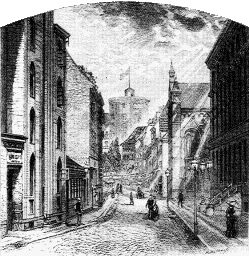
The palaces likewise, with no exterior splendor, but with gardens and honest-looking rooms, gave one the feeling that royalty made itself comfortable rather than spectacular. The museums were housed in palaces, the Thorwaldsen one only being in a building erected for the purpose; and inasmuch as the objects in the museums were largely the odds and ends of past royal living, one enjoyed the sense of being cheek by jowl with the titular great. Indeed, the principal museum, the famous Museum of Northern Antiquities, which occupies the Princes Palace, owes its importance, after the indefatigable zeal of Mr. Thomsen, its great custodian in days gone by, to the unremitting interest which the government and people together have shown in its collections, so that an immense store of objects illustrating the whole range of Scandinavian life has been accumulated within its walls, and arranged with intelligent judgment. It seemed to me much the most popular museum which I ever visited. A living stream of visitors flowed through the rooms, and took a careful chronological course in its movement.
Thorwaldsen’s Museum divides the honors with the Museum of Northern Antiquities, and the traveller, though he may have thought of the frequent reference which Andersen makes to the sculptor, does not need this introduction to a man who divides with Andersen the distinction of Danish fame in the minds of foreigners. The museum is devoted exclusively to originals or copies of Thorwaldsen’s work, and to furniture or works of art which belonged to the sculptor, who made the Danish people his heirs. The first impression which one gets from walking through the galleries is of the astounding productiveness of the man, but the longer he looks the more he is likely to find the marvel comprehensible. Here is, indeed, a great array of statuary, but the same subject recurs repeatedly; the plaster reappears in the marble, and studies abound which indicate the variations upon a certain round of themes. It is a pity that the collection is not so arranged for the student that he may see in a group all the work produced by Thorwaldsen upon a single theme. Instead, the effort is apparently made to secure the widest vanety of artistic grouping so that the separate rooms shall each be agreeable little galleries of sculpture.
Aside from the portrait busts, the few illustrations of religious art for churches, and the occasional memorial sculpture, the great mass of works consists of illustrations of classic fable, and here again one discovers a further limitation in the constant recurreuce by Thorwaldsen to the myth of Amor and Psyche, and the loveliest of his work was the marble group of Amor and Psyche reunited in heaven. There is a series of bass-reliefs entitled “Amor’s Dominion over the World,” and one is tempted to take it as expressing most completely the sculptor’s conception of life. He was a man born with a love of sensuous beauty who came late to a knowledge of the Greek form, and seized upon it, and all the myths which it represented, as sufficient aud satisfying. After that lie desired chiefly to reproduce the Greek idea as it swayed his own life. There is thus little thought in his work, little attempt at losing himself in a great idea, little imagination, but considerable fancy, and great fertility in the use of Greek examples. These lie handled as the material which was familiar to him, and he never got far from tIme use of a few simple forms.
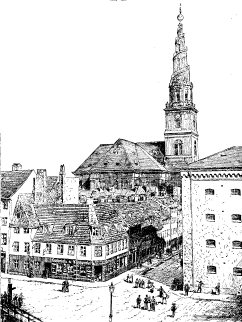
There was one curious invention as applied to Christian art and that was in a whimsical illustration of the story of Adam and Eve. They are represented seated together, while Adam holds Abel on his knee. An altar fire burns near. Abel has an apple in his uplifted hand, and Cain, who is on the ground, spurns another apple with his foot, at time same time snatching at Abel’s. The serpent looks upon this family group, which appears to have been Thorwaldsen’s sculpturesque conception of an antithesis to the Holy Family. But in the treatment of the subject of Christian art one is apt to discover how completely Thorwaldsen was dominated by a Greek and, I may add, a pagan sense. He was often called upon for memorial stones, and his conception of Death was always one of fear. Such triumph as he delineated was always that of a sublimated human passion, as instanced in Psyche. In the direct subjects of the Christ and the Apostles the twelve are merely conventional figures, with scarcely any individuality springing from personal or typical traits, and the Christ was the elegant work of a man whose thought was controlled by Greek lines and inspired by a traditional Protestantism.
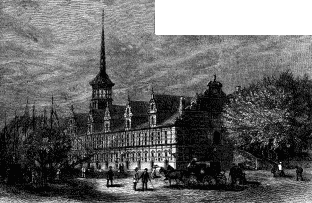
I have strayed a little from my subject, but Thorwaldsen and his work give a special significance to Danish life, which has a very lively interest in questions of art. The gallery, the ballet, the theatre, music, and literature are constantly making demands upon popular attention, and receiving the meed of discussion at any rate. Any one reading Andersen’s life is struck by the village-like character of the society in which he moved, by the rough-and-tumble life which the followers of the arts endured, and the jostling criticism which fell to every one’s share. It was midsummer when I was in Copenhagen, and I had no opportunity to see some of the dramatic representations which give distinction to Denmark; but I went to Tivoli with every one else, and saw there a characteristic side of life.
Tivoli is not so unique a place as it once was, for the fashion which it set has been abundantly copied; but it remains as one of the most interesting of summer gardens, and this for the simple reason that Danish society is nucompromisingly democratic and homogeneous. There are absolutely no places of amusement in Copenhagen which have a class distinction. At Tivoli one sees the richest and most gentle by the side of the poorest and humblest. It is a social exchange where there is the most complete consideration for every one.
I went to Tivoli one evening when there was to be a series of entertainments especially for children. I can not say that there was very much novelty in the programme. There was a varied and skillful use of the customary sports; jugglers and strong men made the astonishing common-place; brass bands and string bands played at judicious distance from each other; pantomime and comedy were housed under cover, while the audience stood outside; whirhigigs went round, balloons went up, and there was one extraordinary amusement, which may have been reproduced elsewhere, but never chanced to come in my way. It is called in Danish Rutschban, and may as well be dubbed in English rush-railway. A tower stands. at either end of a railway, which is perhaps a hundred and eighty feet in length, forty feet high at one extremity, and half as high at the other. I climbed the rude staircase of the higher tower, and found myself in a room crowded with people waiting tbeir opportunity for a ride. At the entrance stood a phaeton-like car on four small iron wheels, the car being very stout, and holding two people with comfort. The wheels were in grooves, and the course extended over the descending and ascending slopes. Two people would get into the car and be strapped in by a leathern boot; tbe car would be started down the inclined plane by an attendant, and away it would go down the first slope, and by its impetus rise to the next height, go over and down and up again at each rise pitching a little lower, at each pitch rising to a lesser height, until the last

I stood by the entrance where the car started down, watching the couples get into the vehicle and then go thundering down the slope. I saw sedate men who might have been bank presidents get in, and children, and ardent youths and maidens, two by two. They held each other in; they almost lost their hats; they bowed, and fell back upon the huge “thank-you-ma’ams”; they looked frightened, and they looked bold; they smiled, and they almost cried; but I heard no one scream. At length, when I had politely given way to those more eager, I was driven by shame and an inextinguishable curiosity to try this reckless “coast.” I paid the fare—about two and a half cents—and took my seat. I jammed my hat down over my brow, grasped the back of the car with one hand, and no doubt turned pale as the push was given and we began that awful descent. I felt that thrilling sensation of vibration in the pit of my stomach which one has in a swing when descending, and then we shot up the slope, saw a new abyss, and plunged into it. A delicious reprieve was followed by another fearful descent; four times we dashed in the face of fate, and then, with one triumphant rush, flew up the last incline. I got out of the car with my wits standing on end, and tumbled down the staircase in a bewildered, groggy way, anxious to get my legs upon the immovable earth again.
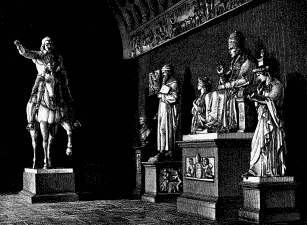
There was no mistaking the thorough enjoyment which everybody took in this amusing place, and the decorum and good feeling seemed to come by nature. The applause was enthusiastic and energetic, and one formed a most agreeable impression of the sociability of the people. No doubt something is due to the absence of a foreign element. All are Danes, and know each other as people do in a large village.
May I add that this democratic spirit was specially agreeable in the grave-yards? I went to the large cemetery where Andersen lies buried. Good taste was universally shown, and there was no display. Simple tablets and little family lots neatly ordered seemed to suggest no distinction of class or wealth. But it was odd to see how titles were always scrupulously placed on the stone, or if the man had no honorary title, then his occupation, so that one learned that Wine-merchant Pedersen lay buried here, Musical-instrument-maker Frederik Richter there, and in one Place I read, “This stone is raised to the memory of the Veteran Chocolate-manufacturer Reimer Timotheus Kehiet.” I found Andersen’s resting-place after considerable search. A neat Scotch granite stone stands in a small inclosure, where roses bloom in a box-bordered pint, and ivy vines and a prickly thorn give constant greenness. On the stone are Andersen’s name, date of birth and death, and a stanza from one of his poems, which I venture to translate:
The soul which in God’s own image is made,A fading wreath lay at the foot of the stone, placed there ten days before, on the anniversary of his death. I was glad to think that lie lay in so quiet a place.
Eternal is—can never fade
Eternity’s seed in our life doth lie—
The body may fall, the soul can not die.

It chanced to me to have entrance into the family life of Roughed, upon the outskirts of the city, where Andersen spent many happy days, and where he died. I was in the midst there of familiar memories of Andersen, and got at his home life, as it may not be unfair to call it, if it was a borrowed home. Through the glimpses of sketches and photographs I saw him in the garden, lying upon the grass, talking with the painter Bloch, receiving a little child as she gravely brought him a stork and a doll, seated at his table, and among his books. Here he read his new stories as he wrote them, and listened, not always with patience, but always with instruction, to the criticisms offered, and so worked and reworked his little fancies. He had an odd genius for cutting out figures, and there was a drawing which he had made to preserve some view, curiously good and stiff, like the work of a very old master.
Andersen’s life, when not spent in travel, was passed chiefly in Copenhagen. Thither he came to seek his fortune when a boy, and rarely did he go hack to his birth-place in Odense; but the reader of his life will recall the early days there, and the hrief triumph when the city was illuminated and a celebration held on the seventieth anniversary of Andersen’s birth. I spent a few hours in the old town before leaving Denmark, and traced the few signs not yet obliterated of the story-teller’s childhood there. The house where he was born is pulled down, but the house associated with his childhood still stands, altered, as the neighborhood is. A tablet upon the side of the house commemorates the poet’s connection with it, but I could not discover the corner in the roof where was the little garden which he describes so charmingly in The Snow Queen. The Bell’s Hollow I saw in the deep shade of the Bishop’s Garden, and the Monk’s Mill still grinds its meal. Best of all, as I strolled along the river down to which the garden used to run from the house where Andersen lived, I saw a number of ducks paddling about, and to my supreme joy they all set upon one forlorn little duck and began to peck at it. I was content with this. It was worth the visit to Odense to see the veritable Ugly Duckling at the foot of Andersen’s gooseberry-bush garden.